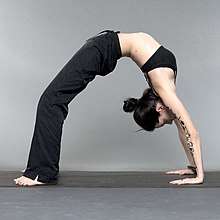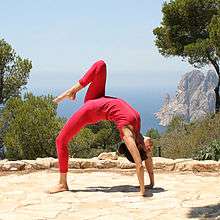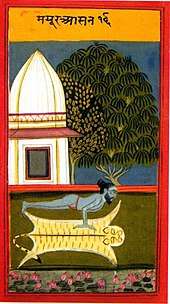Chakrasana
Chakrasana (Sanskrit: चक्रासन IAST: Cakrāsana, Wheel Pose) or Urdhva Dhanurasana (Sanskrit: ऊर्ध्वधनुरासन; IAST: Ūrdhvadhanurāsana, Upward-Facing Bow Pose) is an asana in yoga as exercise. It is a backbend and is the first pose of the finishing sequence in Ashtanga Vinyasa Yoga. It gives great flexibility to the spine. In acrobatics and gymnastics this body position is called a bridge.

Etymology and origins
The name Chakrasana comes from the Sanskrit words चक्र chakra, "wheel", and आसन āsana, "posture" or "seat". The name Urdhva Dhanurasana comes from the Sanskrit urdhva ऊर्ध्व, upwards, and dhanura धनु, a bow (for shooting arrows).[1][2][3]
The pose is illustrated in the 19th century Sritattvanidhi as Paryaṇkāsana, Couch Pose.[4]
Description
In the general form of the asana, the practitioner has hands and feet on the floor, and the abdomen arches up toward the sky. It may be entered from a supine position or through a less rigorous supine backbend, such as Setu Bandha Sarvangasana (Bridge Pose). Some advanced practitioners can move into Wheel Pose by "dropping back" from Tadasana (Mountain Pose), or by standing with the back to a wall, reaching arms overhead and walking hands down the wall toward the floor. Advanced practitioners may also follow wheel with any of its variations (listed below), or with other backbends, such as Dwi Pada Viparita Dandasana, or by pushing back up to stand in Tadasana [5][6]
Benefits

The stretching in Chakrasana helps to tone and strengthen muscles in the back[7] and calves, and is also said to relieve tension and stress in people who sit for long times in front of a desk or computer.[8][9]
Variations
Many variations of the pose are possible, including:
- Eka Pada Urdhva Dhanurasana (One-Legged Upward Bow): one leg is lifted straight up into the air.[10]
- Camatkarasana (Wild Thing Pose) has one arm lifted and the opposite leg straightened.[11]
- Chakra Bandhasana has the forearms on the floor and the hands grasping the heels.[12]
In culture
On its 40th anniversary, Yoga Journal recalled seven ways it had covered Urdhva Dhanurasana, including a cover of Iyengar Yoga teacher Rama Jyoti Vernon doing the pose in its first year, 1975 and Angela Farmer doing the one-legged variant in 1982.[13]
See also
- Viparita Dandasana, Inverted Staff pose, has the back similarly arched but the legs straight and the forearms on the ground.
- List of asanas
References
- "Chakrasana". Ashtanga Yoga. Archived from the original on 2011-03-04. Retrieved 2011-04-11.
- Sinha, S. C. (1996). Dictionary of Philosophy. Anmol Publications. p. 18. ISBN 978-81-7041-293-9.
- Kaul, H. Kumar (1993). Yoga and drug addiction. B.R. Publishing Corporation. p. 92. ISBN 978-81-7018-742-4.
- Sjoman 1999, p. 70.
- "Upward Bow (Wheel) Pose". Yoga Journal. 28 August 2007.
- "Urdhva Dhanurasana: The Full Wheel Pose". Gaia. Retrieved 2016-12-04.
- "Chakrasana – The Yoga Wheel Pose". YogDev. Retrieved 9 August 2016.
- "Upward Bow (Wheel) Pose - Urdhva Dhanurasana - Yoga Pose". Yoga Journal. 2007-08-28. Retrieved 2016-11-27.
- "Chakrasana Health Benefits". Archived from the original on 2018-07-13. Retrieved 2018-07-13.
- "Eka Pada Chakrasana". Jaisiyaram. Retrieved 21 March 2013.
- YJ Editors (31 August 2009). "Wild Thing". Yoga Journal. Retrieved 8 February 2019.
One poetic translation of Camatkarasana means "the ecstatic unfolding of the enraptured heart."
- Iyengar 1979, p. 379.
- EichenSeher, Tasha (9 July 2015). "1 Pose, 40 Years: Urdhva Dhanurasana (Wheel Pose)". Yoga Journal.
Sources
- Iyengar, B. K. S. (1979) [1966]. Light on Yoga: Yoga Dipika. Unwin Paperbacks. ISBN 978-1855381667.CS1 maint: ref=harv (link)
- Sjoman, Norman E. (1999) [1996]. The Yoga Tradition of the Mysore Palace. Abhinav Publications. ISBN 81-7017-389-2.CS1 maint: ref=harv (link)
_from_Jogapradipika_1830_(detail).jpg)

